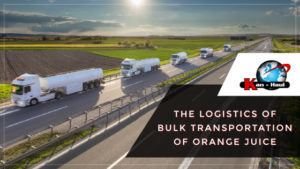January 15, 2021
The Logistics of Bulk Transportation of Orange Juice
 Orange juice is a staple in millions of people’s refrigerators. Between 2019 and 2020, recent research shows that people consumed approximately 532,000 metric tons of orange juice in the United States alone.
Orange juice is a staple in millions of people’s refrigerators. Between 2019 and 2020, recent research shows that people consumed approximately 532,000 metric tons of orange juice in the United States alone.
To supply citizens with the juice that they love, bulk transportation of orange juice is a must, and to get it done right, there are several rules and regulations that must be adhered to, as well as an extensive process that takes oranges from the trees through the process of bulk juice transportation.
Understanding the Bulk Orange Juice Transportation Process
The process that takes an orange and turns it into the juice you find at the store is quite lengthy. Not only does it have to be picked and processed, but it must go through bulk transportation several times before it makes its way to your store’s shelves for you to purchase.
Farming the Product
The first step in the extensive process that is bulk transportation of orange juice is the product’s farming—in this case, oranges. Those in charge of handling the produce need to make sure they are abiding by proper FDA procedure for growing, harvesting, packing, and holding of produce.
Once the produce is ready to be shipped, they’ll be loaded into a bulk transportation vehicle and taken to the necessary processing plant.
Processing the Oranges
Once the oranges have been delivered to the processing plant, they’ll go through several different processes to go from fruit to the juice and/or concentrate that consumers expect. Once it’s processed accordingly, it will be packaged into a bulk transportation truck that is suitable for liquid transportation.
Loading the Bulk Orange Juice for Transportation
Once you’ve chosen a bulk transportation company to work with, it’s essential you make sure the loading of your bulk orange juice follows the following process:
- Upon the arrival of your carrier, your team needs to ensure that the loading dock is thoroughly cleaned. That means ridding the area of all debris that could become hazardous or lead to potential contamination.
- There are two methods used for loading bulk liquid for transportation, including air pressure or roper pump. Both methods utilize a hose and pump, which are hooked up to the access point. It’s at the access point where the loader will pressurize the hoses to confirm there are no leaks. If no leaks are present, the valve can be opened, and the pump can load the carrier.
- Once loaded with the orange juice, the loading team will go through a post-load check to ensure all procedures were followed.
After the post-load checklist is completed, the carrier vehicle will head out to its next location, typically a packaging center.
Unloading the Bulk Orange Juice for Packaging
At this point in bulk transportation of orange juice, it will need to be packaged into containers, then sent off to distributors such as grocery stores or campuses.
When it comes to the unloading process involved with bulk juice, it looks very similar to the loading process, just in reverse. However, when unloading, it’s best to use gravity to prevent any cross-contamination from occurring using a hose and pump (though when gravity isn’t available, it can be done via this method).
It’s also vital that the receiver take a sample of the product before unloading it to have it tested, ensuring there was no contamination before unloading the juice.
Reloading for Distribution
Once the juice has passed inspection and can be unloaded, it will go through the packaging process, which will look a bit different from plant-to-plant.
However, once it’s time to transport the packaged orange juice, you’ll want to make sure you choose a bulk liquid transport vessel that can accommodate your liquid’s needs.
FDA Requirements on Bulk Transportation of Orange Juice
The bulk transportation of orange juice is a serious cycle that must go through an extensive process to get from the farms to your refrigerator. This entire process is overseen by the food and drug administration (FDA) to ensure that the fruits used and the juice produced remain safe for human consumption.
To keep consumer products safe, the FDA recommends that anyone involved in the transportation of juices be familiar with and practice a hazard analysis that focuses on these five areas:
- Sanitation operations
- Equipment design
- Equipment maintenance
- Employee practices
- Loading/unloading areas
These recommendations’ primary focus pertains to cleanliness and keeping the product from being contaminated with any pathogens or other impurities.
Therefore, it is absolutely vital that you research any entity that will be involved in your bulk transportation of orange juice and make sure they are following the necessary procedures to ensure your products’ safety.
Proper sanitization practices are vital to your process, so don’t be afraid to speak with each entity you are working with to ensure that their staff is practicing the necessary hygienic and sanitization measures and that all equipment is being properly maintained.
Bulk Transportation of Orange Juice with Kan-Haul
With 30+ years of experience in the bulk transportation of orange juice and other liquids, we ensure that your products are transported safely and according to all FDA rules and regulations.
Contact us today to discuss your needs regarding the bulk transportation of juices.
